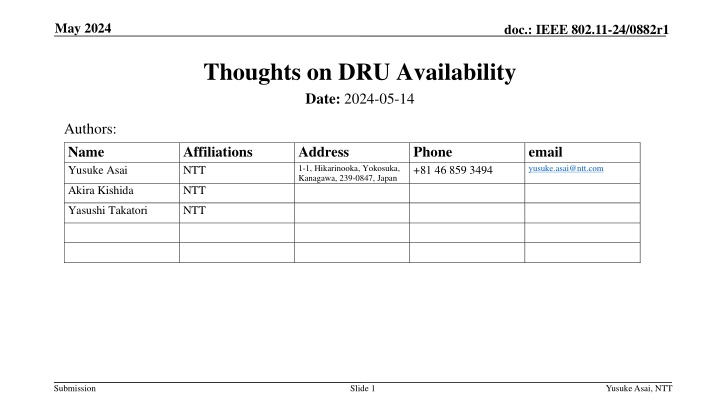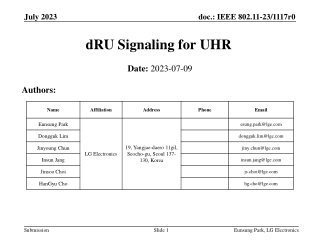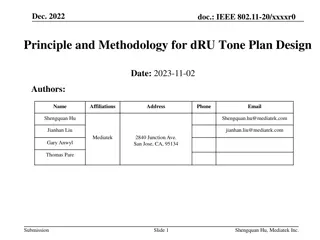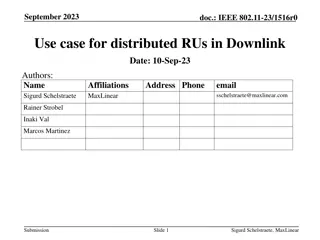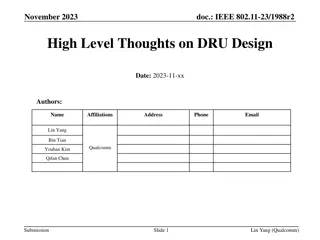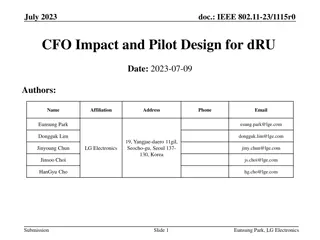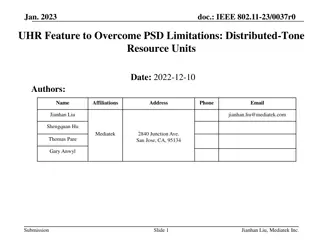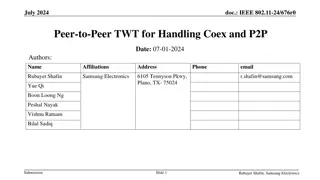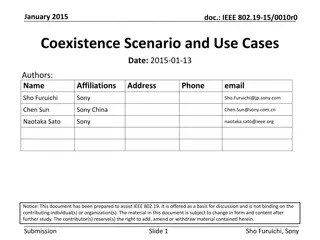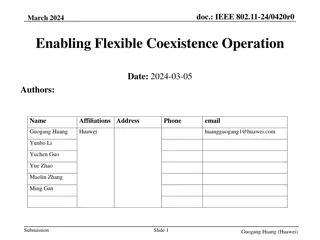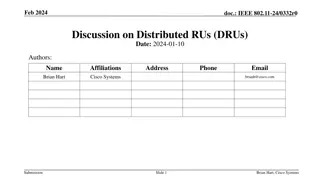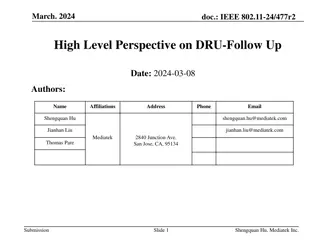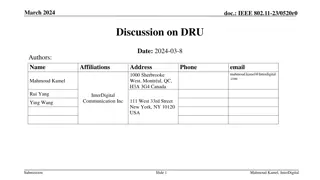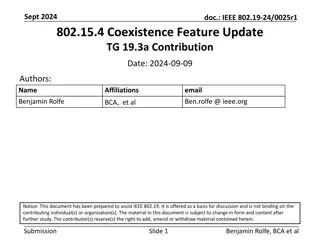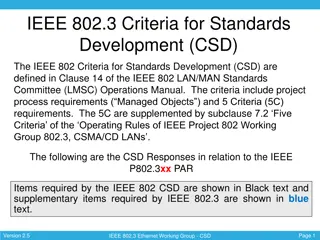DRU Availability in IEEE 802.11-24: Coexistence and Solutions
In May 2024, an overview of DRU in IEEE 802.11-24 is discussed, focusing on its impact on rate-vs-range performance in UHR PHY. The document delves into the challenges of coexistence with existing systems, proposing solutions to maximize DRU availability across regulatory domains.
Download Presentation

Please find below an Image/Link to download the presentation.
The content on the website is provided AS IS for your information and personal use only. It may not be sold, licensed, or shared on other websites without obtaining consent from the author.If you encounter any issues during the download, it is possible that the publisher has removed the file from their server.
You are allowed to download the files provided on this website for personal or commercial use, subject to the condition that they are used lawfully. All files are the property of their respective owners.
The content on the website is provided AS IS for your information and personal use only. It may not be sold, licensed, or shared on other websites without obtaining consent from the author.
E N D
Presentation Transcript
May 2024 doc.: IEEE 802.11-24/0882r1 Thoughts on DRU Availability Date: 2024-05-14 Authors: Name Yusuke Asai Affiliations NTT Address 1-1, Hikarinooka, Yokosuka, Kanagawa, 239-0847, Japan Phone +81 46 859 3494 email yusuke.asai@ntt.com Akira Kishida NTT Yasushi Takatori NTT Submission Slide 1 Yusuke Asai, NTT
May 2024 doc.: IEEE 802.11-24/0882r1 Abstract Since the UHR SG era, there have been many technical discussions on DRU[1]-[26]. DRU is expected to improve rate-vs-range performance in UHR PHY by increasing transmit power per subcarrier compared to regular RU. TGbn has already decided to include DRU in the SFD[25]. On the other hand, there are some concerns about coexistence with existing systems[14]. In this contribution, we discuss on coexistence with existing systems and the possible solution for maximizing DRU availability. Submission Slide 2 Yusuke Asai, NTT
May 2024 doc.: IEEE 802.11-24/0882r1 Overview of DRU [1] In DRU, subcarrier is allocated entire of channel bandwidth by interleaved manner. When the EIRP limit is defined as power per unit bandwidth (e.g. dBm/MHz), DRU boosts the limit of transmit power per subcarrier in UL-OFDMA compared to the case of regular RU. As a result, rate-vs-range performance in UL-OFDMA is improved. AP STA1 STA2 STA3 Submission Slide 3
May 2024 doc.: IEEE 802.11-24/0882r1 Total transmit power in DRU transmission In UL-OFDMA transmission, each STA conducts transmit power pre-correction[26]. 11ax defined the pre-correction to adjust the received power of its RU at the AP as TargetRxpwr. Transmit power at each STA depends on path loss between the AP and the STA (PLDL). If the power pre-correction scheme in 11ax is used not only to regular RU but also DRU, it is expected that total transmit power for all STA in DRU case will be more that that in regular RU case. In addition, some submissions consider to apply DRU in multi-AP coordination case, which may also increase total transmit power[24]. The number of STAs are expected to be more compared to that of single AP case. Submission Slide 4 Yusuke Asai, NTT
May 2024 doc.: IEEE 802.11-24/0882r1 Coexistence with the Existing Systems It is important to coexist between 11bn and the existing systems. DRU is newly defined in 11bn, and thus coexistence studies will be conducted in the future. It is not yet guaranteed that all DRU variations defined in 11bn will be available. We should consider there might be some restriction to DRU usage for compliance with the existence systems. Because the UL-OFDMA transmission using DRUs essentially increases total transmit power at a time compared with that using the regular RUs. In addition, we should also be aware that regulatory rules are different among regulatory domains. This suggests that the availability of DRU may be different between regulatory domains. To maximize availability of DRU in various regulatory domains, it is beneficial to make the specification of DRU as flexible as possible in advance. Submission Slide 5 Yusuke Asai, NTT
May 2024 doc.: IEEE 802.11-24/0882r1 Possible Proactive Solutions By defining DRU parameters as flexible as possible, it will help to easily adjust the regulatory requirements that depends on each regulatory domain. Possible solutions are as follow (details are TBD and we need further studies): Limiting the set of DRU variations Limiting the DRU bandwidth Limiting maximum transmit power per STA (independent to transmit power envelope element) Submission Slide 6 Yusuke Asai, NTT
May 2024 doc.: IEEE 802.11-24/0882r1 Conclusion DRU is one of the key functions in 11bn to improve rate-vs-range performance. It is also important to consider regulatory compliance in DRU transmission. We should consider there might be some restriction to DRU usage for compliance with the existence systems in advance. To maximize availability of DRU in various regulatory domains, it is beneficial to make the specification of DRU as flexible as possible in advance. Submission Slide 7 Yusuke Asai, NTT
May 2024 doc.: IEEE 802.11-24/0882r1 References [1] Jianhan Liu, et al., "UHR Feature to Overcome PSD Limitations: Distributed-Tone," 11-23/0037r0. [2] Eunsung Park, et. al., "Considerations on RU / MRU Designs for UHR," 11-23/0281r0. [3] Eunsung Park, et. al., "dRU Signaling for UHR," 11-23/1117r0. [4] Eunsung Park, et. al., "Future Considerations on DRU," 11-23/1448r0. [5] Eunsung Park, et. al., "dRU Proposal," 11-23/1919r1. [6] Li yang, et. al., "High Level Thoughts on DRU Design," 11-23/1988r2. [7] Shengquan Hu et. al., High-Level Perspectives on Distributed Tone RU for 11bn, 11-23/2020r1. [8] Shengquan Hu, et. al., "Principle and Methodology for dRU Tone Plan Design," 11-23/2021r1. [9] Mahmoud Kamel, et. al., Data Tones Grouping in Tone-Distributed RUs, 11-23/2031r2. [10] Ensung Park, et. al., "Further Thoughts on dRU," 11-24/0014r0. [11] Thomas Handte, A dRU Design Approach for 20 MHz, 11-24/0078r1. [12] Ross Jian Yu, et. al., "Distribution bandwidth of DRU," 11-23/2200r0. [13] Ensung Park, et. al., Hybrid PPDU and Distribution Bandwidth for DRU," 11-24/0400r0. Submission Slide 8 Yusuke Asai, NTT
May 2024 doc.: IEEE 802.11-24/0882r1 References [14] Brian Hart, "Discussion on Distributed RUs (DRUs)," 11-24/0332r0. [15] Ensung Park, et. al., Multiple DRU Follow Up," 11-24/0401r0. [16] Ensung Park, et. al., 20 MHz Tone Plan and Pilot Design for DRU," 11-24/0402r1. [17] Sigurd Schelstraete, et. al., Range Extension with dRU, 11-24/0429r0. [18] Shengquan Hu, et. al., DRU Tone Plan for 11bn, 11-24/0468r1. [19] Shengquan Hu, et. al., High Level Perspective on DRU-Follow Up, 11-24/0477r2. [20] Bo Gong, et. l., Tone Plan Design for Distributed RU, 11-24/0476r0. [21] Lin Yang, et. al., Follow Up on High Level Thoughts on DRU Design, 11-24/0500r0. [22] Lin Yang, et. al., Pilot Design Considerations for dRU, 11-24/0501r0. [23] Mahmoud Kamel, et. al., Discussion on DRU, 11-24/0520r1. [24] Leonardeo Lanante, et. al., Multiple AP Transmissions Using DRU, 11-24/0524r0. [25] Alfred Asterjadhi, "TGbn Motions List - Part 1," 11-24/0171r1. [26] IEEE Std. 802.11ax-2021. Submission Slide 9 Yusuke Asai, NTT
